GoTo Bundle
How Does GoTo Company Thrive in Southeast Asia's Digital Realm?
GoTo, Indonesia's digital behemoth, has reshaped daily life with its integrated services. The merger of Gojek and Tokopedia created a powerful ecosystem, and its impressive financial performance, including a 30% revenue surge in 2024, highlights its rapid growth. Understanding the GoTo SWOT Analysis is key to grasping its strategic positioning and future potential.
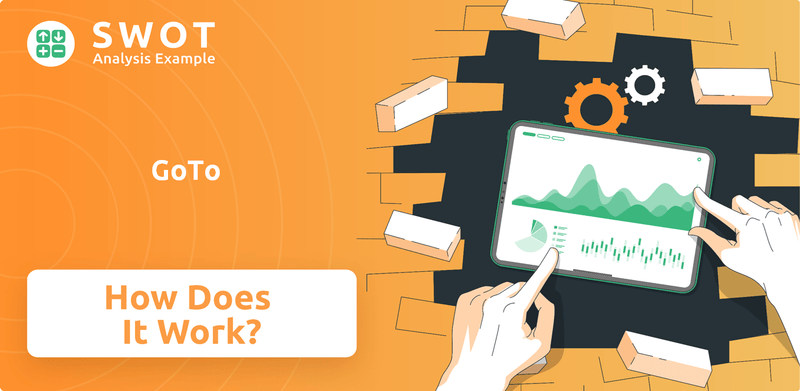
This exploration will dissect the GoTo company's core operations, revealing its diverse revenue streams and strategic initiatives. We'll examine the GoTo platform's unique ecosystem model, which efficiently caters to various demographics, and analyze the GoTo products to understand how they drive innovation and maintain a competitive edge. Whether you're curious about GoTo features, GoTo pricing, or GoTo alternatives, this analysis provides a comprehensive view of its business model.
What Are the Key Operations Driving GoTo’s Success?
The core operations of the GoTo company are centered around its integrated digital ecosystem. This ecosystem delivers value through its key platforms: Gojek, Tokopedia, and GoTo Financial. The company aims to empower progress by providing technology-enabled solutions for everyday challenges, catering to a broad spectrum of customers, from individual consumers to micro, small, and medium-sized enterprises (MSMEs).
The GoTo platform offers a variety of services designed to meet diverse needs. This includes on-demand services such as ride-hailing, food delivery (GoFood), grocery shopping, and logistics. Additionally, GoTo products extend to financial services, encompassing digital payments and lending solutions. The company's operational model is built on a foundation of seamless integration and data-driven decision-making, enhancing customer convenience and loyalty.
The company's value proposition is to offer a unified and efficient experience across various services, simplifying daily tasks for consumers and providing growth opportunities for businesses. Through strategic partnerships and continuous innovation, GoTo strives to remain at the forefront of the digital economy, contributing to economic development and technological advancement in the regions it serves.
In Q1 2025, Gojek's On-Demand Services experienced significant growth. Gross Transaction Value (GTV) rose by 17% year-over-year (YoY) to Rp 15.7 trillion. Both Mobility and Delivery services saw a 17% growth. Net revenue for On-Demand Services increased by 33% YoY, reaching Rp 3.0 trillion.
As of early 2024, Tokopedia was integrated with TikTok Indonesia, with GoTo retaining a 24.99% minority share. While e-commerce services are still available on the GoTo app, the company is shifting its focus. On-demand services are expected to account for the majority of revenue, with financial services expanding rapidly.
GoTo Financial's net revenue in Q1 2025 increased by 90% YoY to Rp 1.2 trillion. This growth was driven by a 108% YoY expansion in its loan book, which reached Rp 5.7 trillion. The segment's adjusted EBITDA reached a record Rp 47 billion, marking its second consecutive profitable quarter.
GoTo generates an average of Rp 1.5 trillion per month in income for its driver-partners. In 2024, the company expanded its low-emission initiatives. There were 6,500 active driver partners using electric vehicles (EVs) monthly, with a fivefold increase in completed EV bookings.
The GoTo company leverages its integrated platform to provide a seamless experience, enhancing customer convenience. The company focuses on data-driven decision-making and strategic partnerships. For more insights, check out the Marketing Strategy of GoTo.
- On-Demand Services GTV grew by 17% YoY in Q1 2025.
- GoTo Financial's net revenue increased by 90% YoY in Q1 2025.
- The loan book of GoTo Financial reached Rp 5.7 trillion.
- GoPay's MTUs grew 35% YoY to 20.2 million in Q4 2024.
GoTo SWOT Analysis
- Complete SWOT Breakdown
- Fully Customizable
- Editable in Excel & Word
- Professional Formatting
- Investor-Ready Format
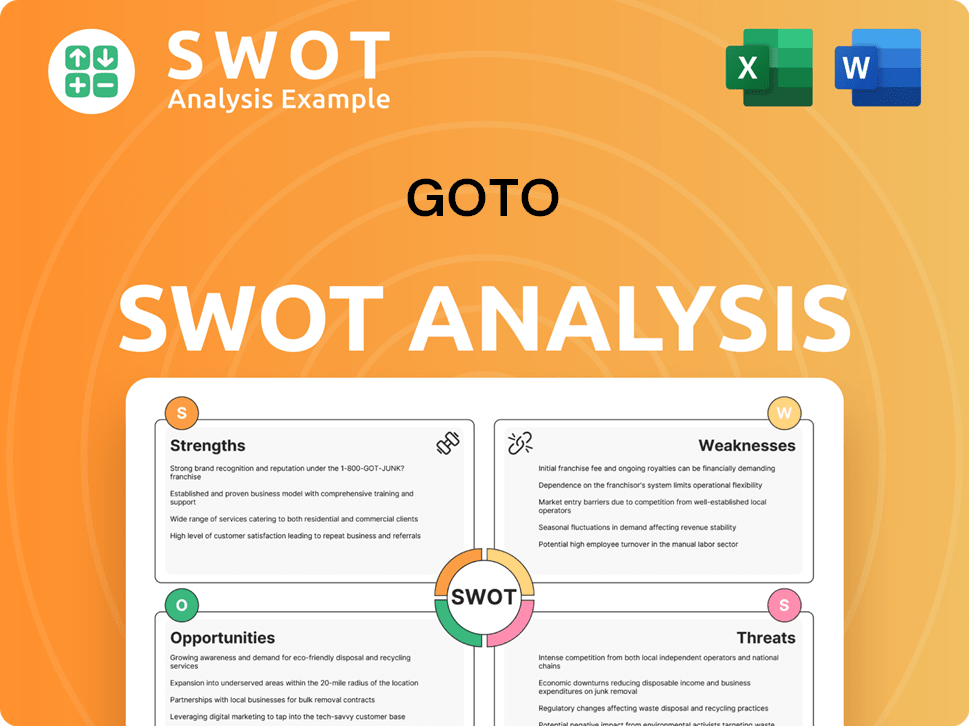
How Does GoTo Make Money?
The GoTo company generates revenue through a diverse range of streams, encompassing on-demand services, e-commerce, and financial technology. The GoTo platform leverages these streams to offer integrated solutions, driving growth and profitability. For the full year 2024, the company's gross revenue rose 30% to Rp 18.1 trillion.
In Q1 2025, the company's net revenue increased by 37% year-over-year to Rp 4.2 trillion, showcasing strong financial performance. This growth is fueled by strategic monetization strategies and the expansion of its ecosystem. The company continues to focus on enhancing user experience and operational efficiency to further boost revenue.
The GoTo products generate revenue through various channels, including on-demand services, financial technology, and e-commerce. In Q1 2025, net revenue increased by 37% year-over-year to Rp 4.2 trillion.
Here's a breakdown of the key revenue streams for the GoTo company:
- On-Demand Services: This segment includes ride-hailing, food delivery, and logistics. In Q1 2025, On-Demand Services net revenue increased by 33% year-over-year to Rp 3.0 trillion, with Mobility and Delivery contributing to this growth. The company optimizes its product mix and tailors services to expand mass-market adoption while capturing higher spending from affluent users through premium offerings and product innovation. Advertising revenue and disciplined promotional spending also contribute to margin expansion in this segment.
- Financial Technology: This rapidly scaling segment includes the GoPay app and consumer lending. In Q1 2025, GoTo Financial's net revenue increased by 90% year-over-year to Rp 1.2 trillion, driven by the significant scaling up of its loan book, which expanded by 108% year-over-year to Rp 5.7 trillion. Lending revenue alone grew by 168% year-over-year to Rp 763 billion in Q1 2025. The financial technology segment achieved positive adjusted EBITDA of Rp 14 billion in Q4 2024 and Rp 47 billion in Q1 2025, making an increased contribution to Group revenue and profitability.
- E-commerce: Although the company divested its e-commerce unit to TikTok in 2024, retaining a minority 24.99% share, it still generates service fees from Tokopedia. For the full year 2024, e-commerce service fees from Tokopedia were Rp 690 billion, and Rp 204 billion in Q4 2024. In Q1 2025, e-commerce service fees from PT Tokopedia were Rp 217 billion.
The company employs several monetization strategies, including platform fees, bundled services, tiered pricing, and cross-selling within its ecosystem. The expansion of consumer loans within the GoTo ecosystem demonstrates a successful cross-selling strategy. The company is also focusing on strengthening monetization through higher take-rate financial products. For more insights into the company's structure, you can explore Owners & Shareholders of GoTo.
GoTo PESTLE Analysis
- Covers All 6 PESTLE Categories
- No Research Needed – Save Hours of Work
- Built by Experts, Trusted by Consultants
- Instant Download, Ready to Use
- 100% Editable, Fully Customizable
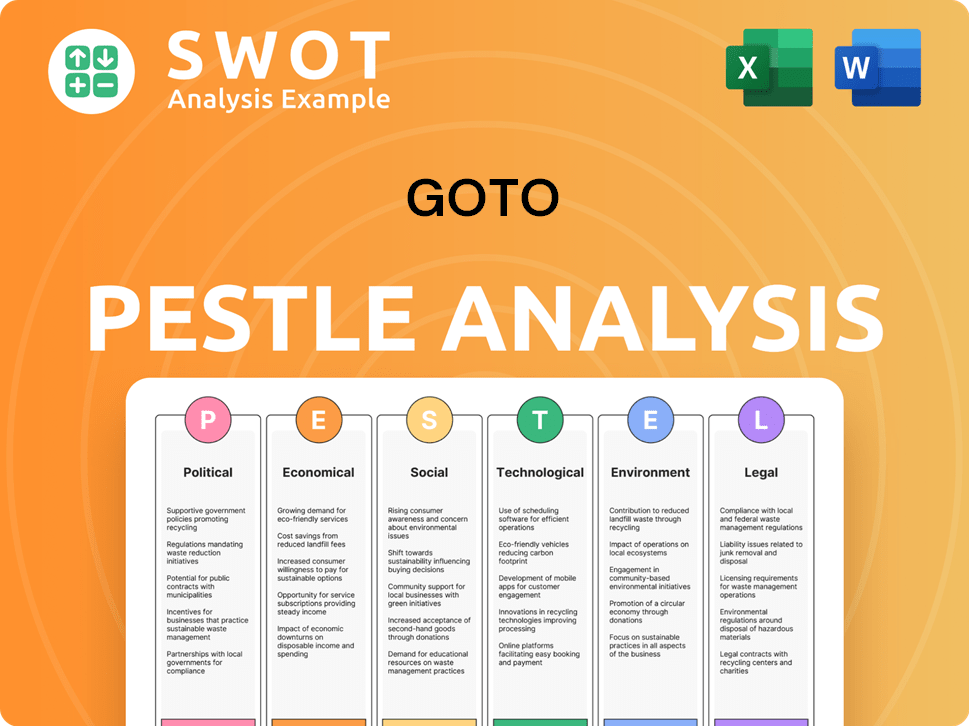
Which Strategic Decisions Have Shaped GoTo’s Business Model?
The journey of the digital ecosystem, has been marked by significant milestones and strategic shifts. A pivotal moment was the merger of Gojek and Tokopedia in May 2021, creating Indonesia's largest digital ecosystem. This strategic combination aimed to integrate various services, enhancing user convenience and market reach.
In 2024, a key strategic move was the divestiture of its e-commerce unit to TikTok, with GoTo retaining a 24.99% minority share. This decision allowed GoTo to concentrate on its core strengths, particularly its on-demand services and financial technology segments. This shift has been instrumental in optimizing the business model for profitability and focusing on sustainable growth.
The company has demonstrated resilience and adaptability in navigating market challenges. Despite a net loss of Rp 3.1 trillion (approximately $188.8 million USD) for the full year 2024, GoTo significantly narrowed its losses by 96% compared to Rp 87.3 trillion in 2023. This turnaround was driven by strong financial performance, with gross revenue increasing by 30% for the full year 2024 to Rp 18.1 trillion and adjusted EBITDA reaching Rp 386 billion.
GoTo achieved its first full quarter of positive adjusted EBITDA in Q4 2024, reaching Rp 399 billion, and continued this momentum into Q1 2025 with an adjusted EBITDA of Rp 393 billion. This demonstrates the effectiveness of the company's strategic focus and operational improvements. The company’s financial strategy focuses on enhancing profitability.
The competitive edge of the GoTo platform stems from its integrated services, creating a seamless experience for users. This approach enhances customer loyalty and convenience. Its scalability allows it to adapt to market changes and expand its services to a larger customer base.
Data-driven decision-making and strategic partnerships also provide a competitive edge. For example, the GoPay app, now standalone, has attracted millions of new users, and the company has significantly expanded its consumer loans offering, growing its loan book by 172% YoY in Q4 2024. GoTo is also investing in cutting-edge technologies like artificial intelligence through its 'Sahabat-AI' initiative to improve operational efficiency and enhance user experience.
The company's commitment to social responsibility and ESG performance, including reducing carbon footprint and promoting environmentally friendly practices, also contributes to its brand strength and long-term sustainability. The company is committed to sustainable practices. To learn more about the company's evolution, you can read this article about the GoTo company.
The strategic moves of GoTo, such as the merger and the divestiture of its e-commerce unit, have significantly shaped its trajectory. These decisions have allowed the company to focus on core strengths and improve financial performance. The focus on on-demand services and fintech is a key element of its strategy.
- Merger of Gojek and Tokopedia created a powerful digital ecosystem.
- Divestiture of e-commerce unit allowed focus on core services.
- Expansion of GoPay and consumer loans enhanced financial services.
- Investment in AI and sustainability initiatives for long-term growth.
GoTo Business Model Canvas
- Complete 9-Block Business Model Canvas
- Effortlessly Communicate Your Business Strategy
- Investor-Ready BMC Format
- 100% Editable and Customizable
- Clear and Structured Layout
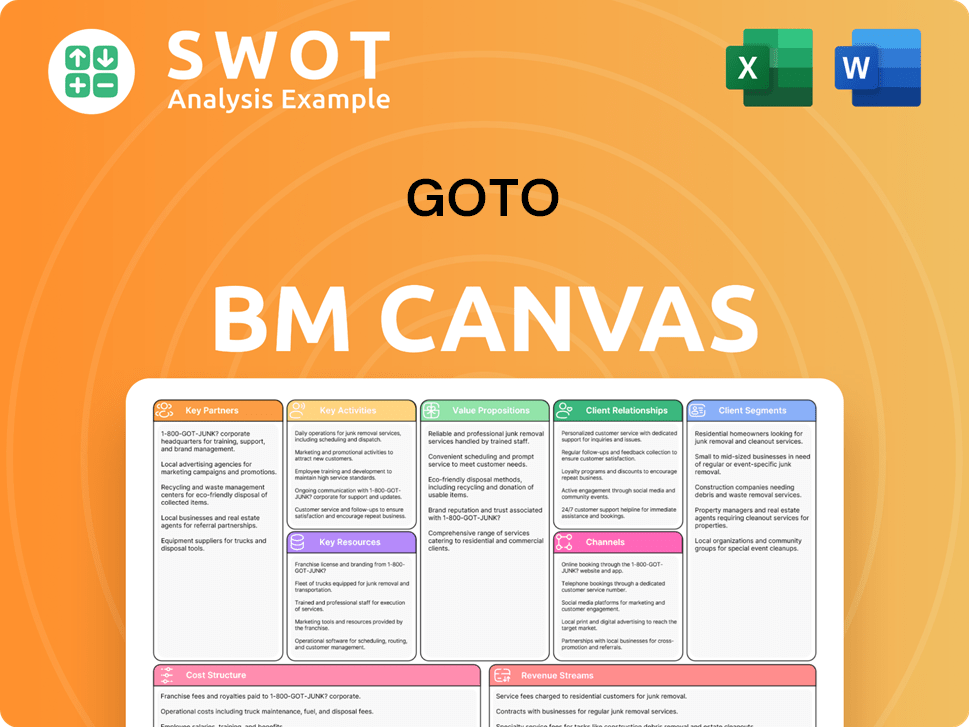
How Is GoTo Positioning Itself for Continued Success?
The GoTo company holds a significant position in Indonesia's digital landscape, functioning as the largest digital ecosystem. This platform provides a wide array of services including mobility, food delivery, logistics, payments, and financial services. The GoTo platform has a strong competitive edge due to its integrated nature, despite facing competition in various sectors.
However, the GoTo company faces several risks. Competition in on-demand services remains intense, and the undifferentiated nature of some services could lead to users switching to other platforms. The company's historical reliance on subsidies to attract users and the changing consumer preferences pose further challenges. Also, regulatory changes and technological disruptions can impact the company's performance.
GoTo products are used by a large number of people. In Q4 2024, Monthly Transacting Users (MTUs) across the GoTo platform increased by 22% year-over-year, and by 16% over the full year. This indicates strong customer engagement and the ability to attract and retain users across its ecosystem.
The company faces intense competition in on-demand services. The reliance on subsidies to attract users and the possibility of users switching to other platforms pose a risk. Regulatory changes and technological disruptions also present challenges. The Target Market of GoTo is also evolving.
The GoTo company is focused on sustaining and expanding its profitability. The company expects full-year 2025 Group adjusted EBITDA to be between Rp 1.4 trillion and Rp 1.6 trillion. Strategic initiatives include tailoring GoTo features for different demographics and user preferences.
The company plans to strengthen its business through operational and product innovations. It aims to boost revenue, increase cost efficiency, and deliver more targeted services. Also, the company is investing in long-term platform enhancements, including its homegrown artificial intelligence initiative, Sahabat-AI.
GoTo company is focused on enhancing its platform through several key strategies. These include the development of tailored products for different demographics and user preferences to efficiently reach a broader audience across Indonesia. The company is committed to operational and product innovations to enhance revenue and efficiency.
- Focus on operational and product innovations.
- Enhance revenue and increase cost efficiency.
- Deliver more targeted and personalized services.
- Invest in long-term platform enhancements, including AI.
GoTo Porter's Five Forces Analysis
- Covers All 5 Competitive Forces in Detail
- Structured for Consultants, Students, and Founders
- 100% Editable in Microsoft Word & Excel
- Instant Digital Download – Use Immediately
- Compatible with Mac & PC – Fully Unlocked
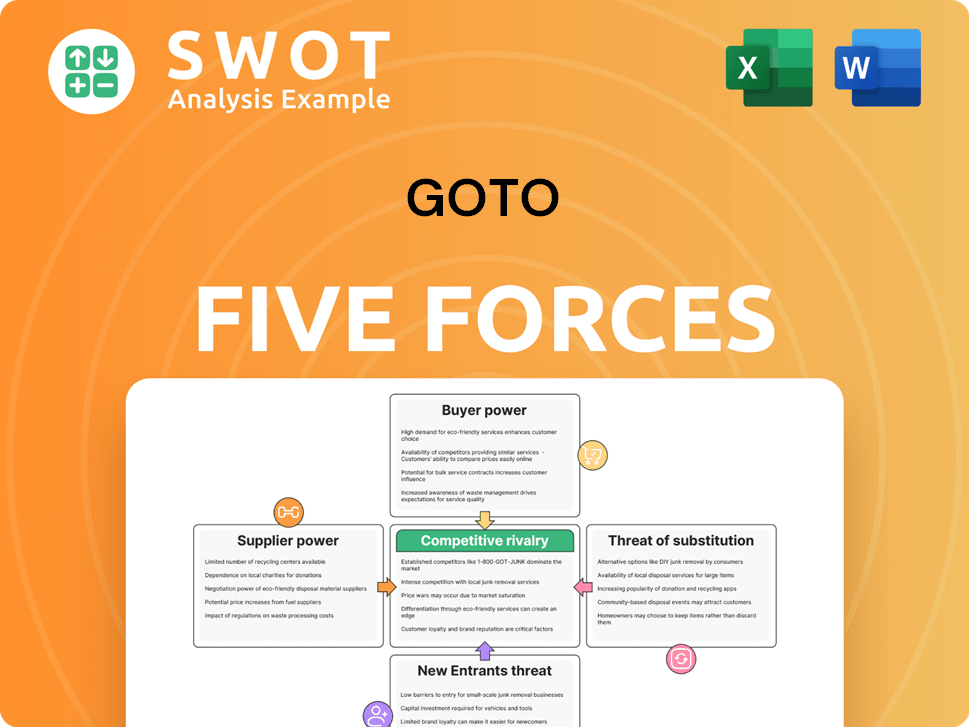
Related Blogs
- What are Mission Vision & Core Values of GoTo Company?
- What is Competitive Landscape of GoTo Company?
- What is Growth Strategy and Future Prospects of GoTo Company?
- What is Sales and Marketing Strategy of GoTo Company?
- What is Brief History of GoTo Company?
- Who Owns GoTo Company?
- What is Customer Demographics and Target Market of GoTo Company?
Disclaimer
All information, articles, and product details provided on this website are for general informational and educational purposes only. We do not claim any ownership over, nor do we intend to infringe upon, any trademarks, copyrights, logos, brand names, or other intellectual property mentioned or depicted on this site. Such intellectual property remains the property of its respective owners, and any references here are made solely for identification or informational purposes, without implying any affiliation, endorsement, or partnership.
We make no representations or warranties, express or implied, regarding the accuracy, completeness, or suitability of any content or products presented. Nothing on this website should be construed as legal, tax, investment, financial, medical, or other professional advice. In addition, no part of this site—including articles or product references—constitutes a solicitation, recommendation, endorsement, advertisement, or offer to buy or sell any securities, franchises, or other financial instruments, particularly in jurisdictions where such activity would be unlawful.
All content is of a general nature and may not address the specific circumstances of any individual or entity. It is not a substitute for professional advice or services. Any actions you take based on the information provided here are strictly at your own risk. You accept full responsibility for any decisions or outcomes arising from your use of this website and agree to release us from any liability in connection with your use of, or reliance upon, the content or products found herein.